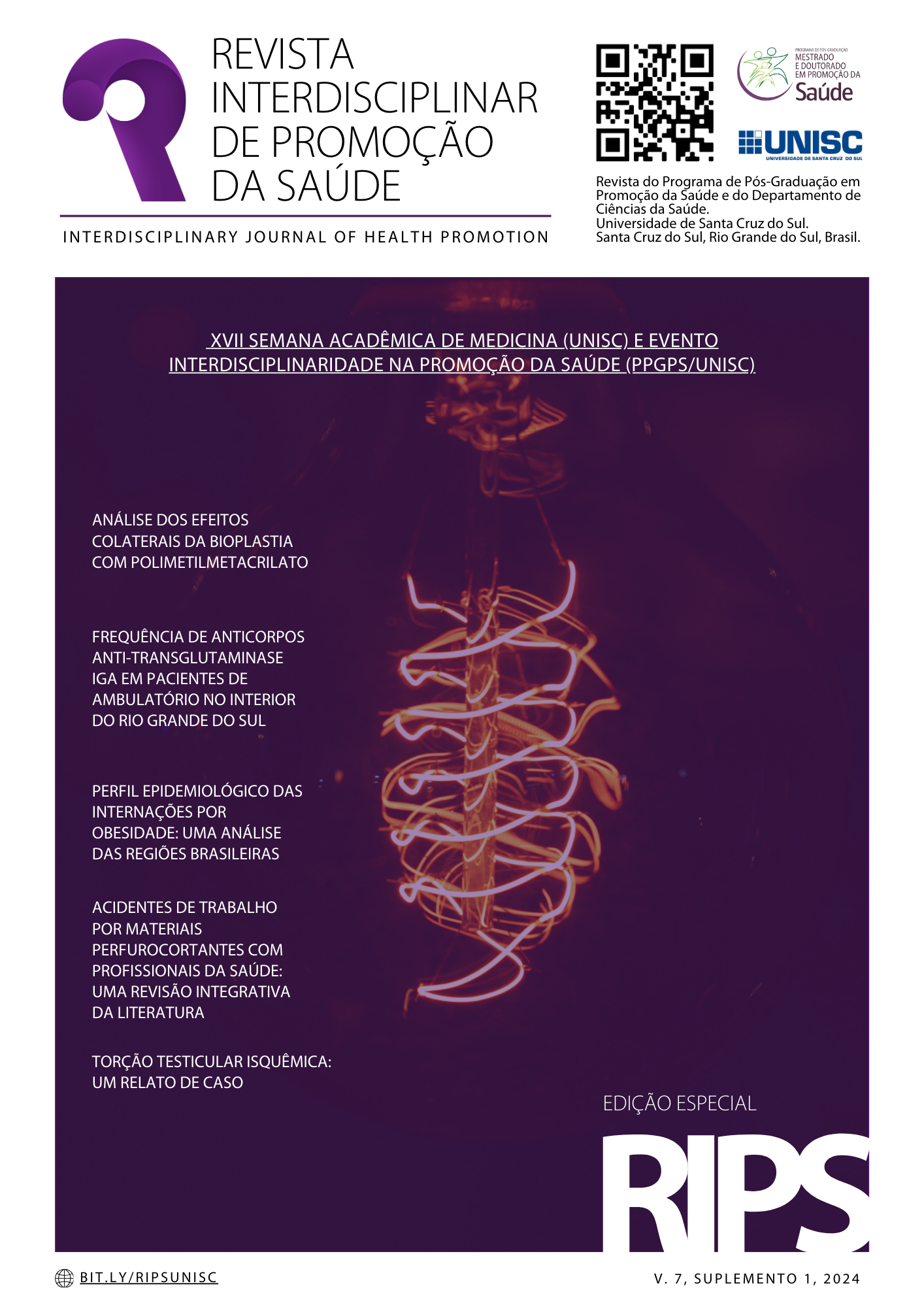Frequency of Anti-Transglutaminase Iga antibodies in outpatients from the interior of Rio Grande Do Sul
DOI:
https://doi.org/10.17058/rips.v7isuplemento.18970Keywords:
Antibodies, Celiac Disease, SerologyAbstract
Introduction: anti-tissue transglutaminase IgA (anti-tTG IgA) is a specific type of antibody produced in response to the presence of the tissue transglutaminase enzyme. The detection of these elevated antibodies in the blood is a sign of immunological activity and may be indicative of the presence of celiac disease (CD). Objective: analyze the frequency of tests for anti-tTG IgA in patients treated at the gastroenterology outpatient clinic of a teaching hospital in the interior of Rio Grande do Sul. Method: retrospective observational study with analysis of medical records of patients treated at the gastroenterology outpatient clinic, from March 2010 to December 2022. For data collection, the variables were analyzed: age, sex, and presence of anti-tTG IgA. Results: the records of 683 patients treated at the gastroenterology outpatient clinic were analyzed, of which 46 had information recorded about the anti-tTG IgA test due to suspected celiac disease. All test results were negative (anti-IgA less than 20.0 U), which suggests the absence of IgA immunoglobulins related to CD in the patients evaluated. Conclusion: despite being highly sensitive, the absence of anti-tTG IgA does not exclude the diagnosis of CD, considering that all celiac patients submitted to analysis at the outpatient clinic had anti-TGA levels lower than 20.0 U/L. IgA deficiency in celiac patients and changes in diet can alter serology, making it necessary to include other more specific serological variables and a biopsy to analyze the villi for greater specificity in detecting gluten autoimmunity. Furthermore, to find the correct frequency of the population in question, a population study with a significant sample is necessary and, in this research, only a retrospective analysis of medical records was carried out.
Downloads
References
César Da Silva P, Del Vigna De Almeida P, Reis De Azevedo L, Maria A, Grégio T, Ângela M, et al. Doença celíaca: revisão. Clin Pesq Odontol 2006 jul-dez; 2(5/6):401-406. Curitiba.
Lindfors K, Ciacci C, Kurppa K, Lundin KEA, Makharia GK, Mearin ML, et al. Coeliac disease. Nat Rev Dis Primers [Internet]. 2019 Jan 10 [citado em 2023 Nov 20]; 5(1):1–18. Disponível em: https://doi.org/10.1038/s41572-018-0054-z
Fuchs V, Kurppa K, Huhtala H, Mäki M, Kekkonen L, Kaukinen K. Diagnóstico tardio de doença celíaca predispõe a redução da qualidade de vida e uso incremental de serviços de saúde e medicamentos: um estudo prospectivo nacional. United European Gastroenterol J 2018; 6(4):567–75.
Beppler BA. A doença celíaca revisada: uma abordagem atualizada sobre seus desafios e perspectivas. São Paulo: Faculdade De Ciências Farmacêuticas - USP; 2021.
Biagi F, Klersy C, Balduzzi D, Corazza GR. Estamos superestimando a prevalência da doença celíaca na população geral? Ann Hum Biol [Internet]. 2010 [citado em 2023 Nov 19]. Disponível em: https://doi.org/10.3109/07853890.2010.523229
Caio G, Volta U, Sapone A, Leffler DA, De Giorgio R, Catassi C, et al. Doença celíaca: uma revisão abrangente atual. BMC Med [Internet]. 2019 Jul 23 [citado em 2023 Nov 19]; 17(1):1–20. Disponível em: https://doi.org/10.1186/s12916-019-1380-z
Collin P, Mäki M, Keyriläinen O, et al. Deficiência seletiva de IgA e doença celíaca. Scand J Gastroenterol 1992; 27:367-371.
Silva M. Diagnóstico de doença celíaca em adultos. Rev Assoc Med Bras 2010; 56(1):367-371.
Rostom A, Murray JA, Kagnoff MF. Revisão técnica do Instituto Americano de Gastroenterologia (AGA) sobre o diagnóstico e manejo da doença celíaca. Gastroenterology 2006 Dec; 131(6):1981-2002. Disponível em: 10.1053/j.gastro.2006.10.004
Kivelä L, Caminero A, Leffler DA, Pinto-Sanchez MI, Tye-Din JA, Lindfors K. Terapias atuais e emergentes para a doença celíaca. Nat Rev Gastroenterol Hepatol 2021; 18(3):181–95.
Downloads
Published
How to Cite
Issue
Section
License
A submissão de originais para este periódico implica na transferência, pelos autores, dos direitos de publicação impressa e digital. Os direitos autorais para os artigos publicados são do autor, com direitos do periódico sobre a primeira publicação. Os autores somente poderão utilizar os mesmos resultados em outras publicações indicando claramente este periódico como o meio da publicação original. Em virtude de sermos um periódico de acesso aberto, permite-se o uso gratuito dos artigos em aplicações educacionais e científicas desde que citada a fonte conforme a licença CC-BY da Creative Commons.




